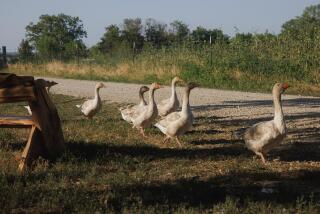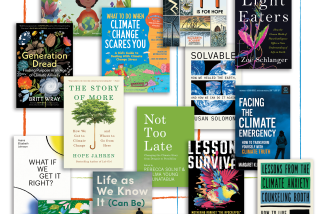An optimistic solution to climate change in ‘Soil Will Save Us’
We generally think of climate change as a story of sky — of emitted gases, of atmospheric carbon levels, of storms. Author Kristin Ohlson would like to direct our gaze earthward, to take a long, hard look at the dirt beneath our feet. We may have overlooked a solution there.
In her sometimes breathless but important new book, “The Soil Will Save Us,” Ohlson lays out a thesis that farmers and climate researchers have been talking about for decades: that a change in farming and forestry techniques could sequester enough carbon in the ground to not only mitigate but reverse global warming.
Yes, it’s a long shot. But this is one of those accessible and well-written science books that walks the lay reader through the development of an idea as it begins to take on relevancy and impact, in scenes describing breakthroughs as they happen on farms and soil labs all over the world.
Ohlson is not a soil scientist, but she is no stranger to journalistic explorations of deep, dark mystery: Her book “Stalking the Divine” hushed us into the world of cloistered nuns in Cleveland and, as co-author of “Kabul Beauty School,” she went “behind the veil” in a unique cosmetology school in Afghanistan.
In “The Soil Will Save Us,” her worthy — though controversial — subject is a group of rogue farmers and scientists bucking conventional farming to stick carbon in the ground via composting, cover crops, no-till techniques, livestock ranching and very modern agro-ecological science. These are not the usual heroes we read about trying to shut down coal-fired power plants or design electric cars.
Ohlson readily acknowledges that efforts to curtail fossil-fuel use are top priority, but then she adds: “However, none of these will actually reduce the legacy load of CO2 already in the atmosphere. There are schemes afloat for doing that, but they’re expensive. ... Not as sexy to policy makers, but free of cost, is Mother Nature’s low-tech approach: photosynthesis and the buildup of carbon in the soil that naturally follows.
“And therein lies our great green hope.”
Them’s practically fightin’ words in activist circles, where the Sierra Club’s Beyond Coal campaign and Bill McKibben’s 350.org, among many others, have struggled to keep the public’s focus on fossil fuels. Ohlson posits her argument as something that has to happen even if greenhouse gas emissions are reduced to zero.
Even more controversial will be the book’s almost inevitable conclusion: If treated right, plants and soil may be able to mitigate all of the world’s greenhouse gas emissions — the rising tide from India and China, all of it.
Of course, it’s not Ohlson making that claim but scientists. And unlike the certainty of the book’s title, most of them clearly say they don’t know yet whether they’re right. Ohlson sticks to her thesis, crafting a thoroughly enjoyable presentation of the evidence as it stands, even if she’s a little too gobsmacked by the science.
And the science is very interesting, if festooned with loose ends. Ohlson uses herself as a character to trace the development of this “carbon farming” idea from Allen Savory’s creation of “holistic grazing” in 1960s Zimbabwe to influential new farmers like Abe Collins in Vermont or Gabe Brown in North Dakota, who has used cover crops, composting and mob grazing to create topsoil 4 feet deep and so productive that he has been able to reduce the amount of acreage he plants and still make a profit — the exact reverse of agribusiness’ credo for the last 70 years, which has been “get big or get out.”
One wants to cheer the idea of turning away from the “nozzle heads” of conventional farming who promote petroleum-based fertilizer, pesticides and herbicides in search of short-term profits. But the conflict is not as clear as all that. The book doesn’t really get into the complexities of global carbon budgeting, leaving lots of room for “leakage” where storing carbon in one place may lead to the release of carbon somewhere else.
Ohlson also knows some of the findings here leave her squeezed between Big Ag and eco-correctness: For instance, the Savory Institute claims that cows and sheep, grazed right, are good for the soil — but livestock have been an environmentalist bogeyman for decades.
What’s missing here is context. There is a section called “Why Don’t We Know This Stuff?” that gives an admirably restrained breakdown of how government and Big Ag-controlled academia prop up conventional food production, but I find myself wishing for the cultural critique that informs McKibben’s “Deep Economy,” which hits on several of these subjects, or the righteous fury of Wendell Berry’s “The Unsettling of America,” which is very much the grandfather of Ohlson’s book though Berry is never mentioned in it.
In the final pages, she highlights some just-released work from two scientists in New Mexico, whose new compost enables massive carbon sequestration and who believe their method could “capture enough CO2 to offset all anthropogenic CO2 emissions on less than 11% of world cropland.” Wow. We can hope.
This is a hopeful book and a necessary one. “The Soil Will Save Us” is not the last word on this subject but is a fast-paced and entertaining shot across the bow of mainstream thinking about land use. May a million new farms bloom.
Kuipers is a writer in Los Angeles.
The Soil Will Save Us
How Scientists, Farmers, and Foodies are Healing the Soil to Save the Planet
Kristin Ohlson
Rodale: 256 pp., $23.99
More to Read
Sign up for our Book Club newsletter
Get the latest news, events and more from the Los Angeles Times Book Club, and help us get L.A. reading and talking.
You may occasionally receive promotional content from the Los Angeles Times.








